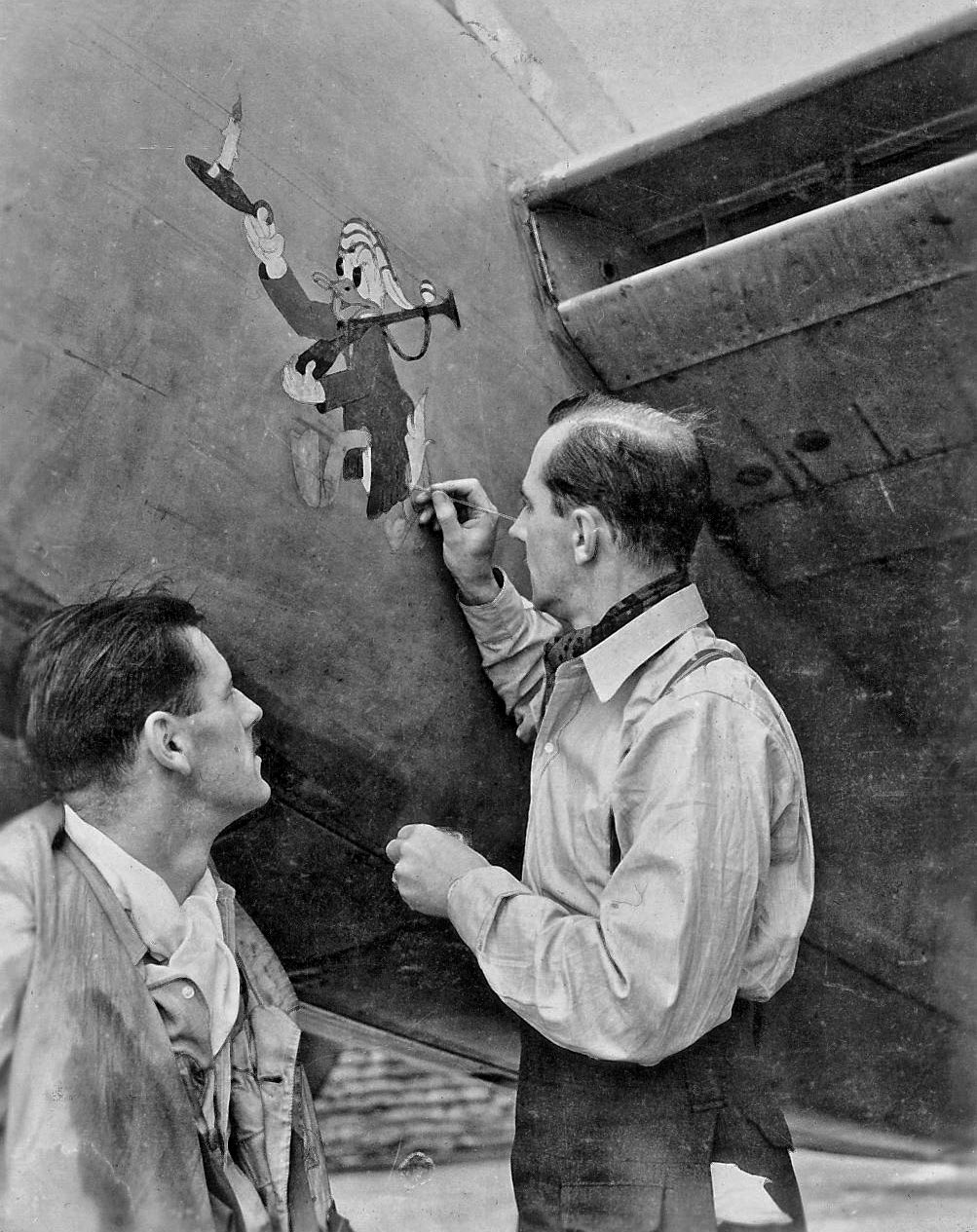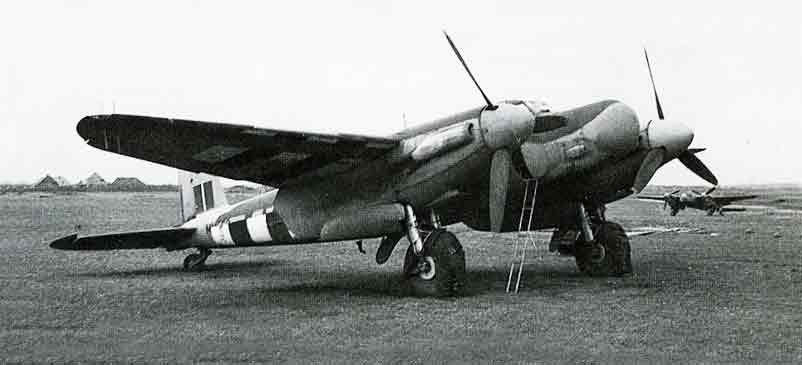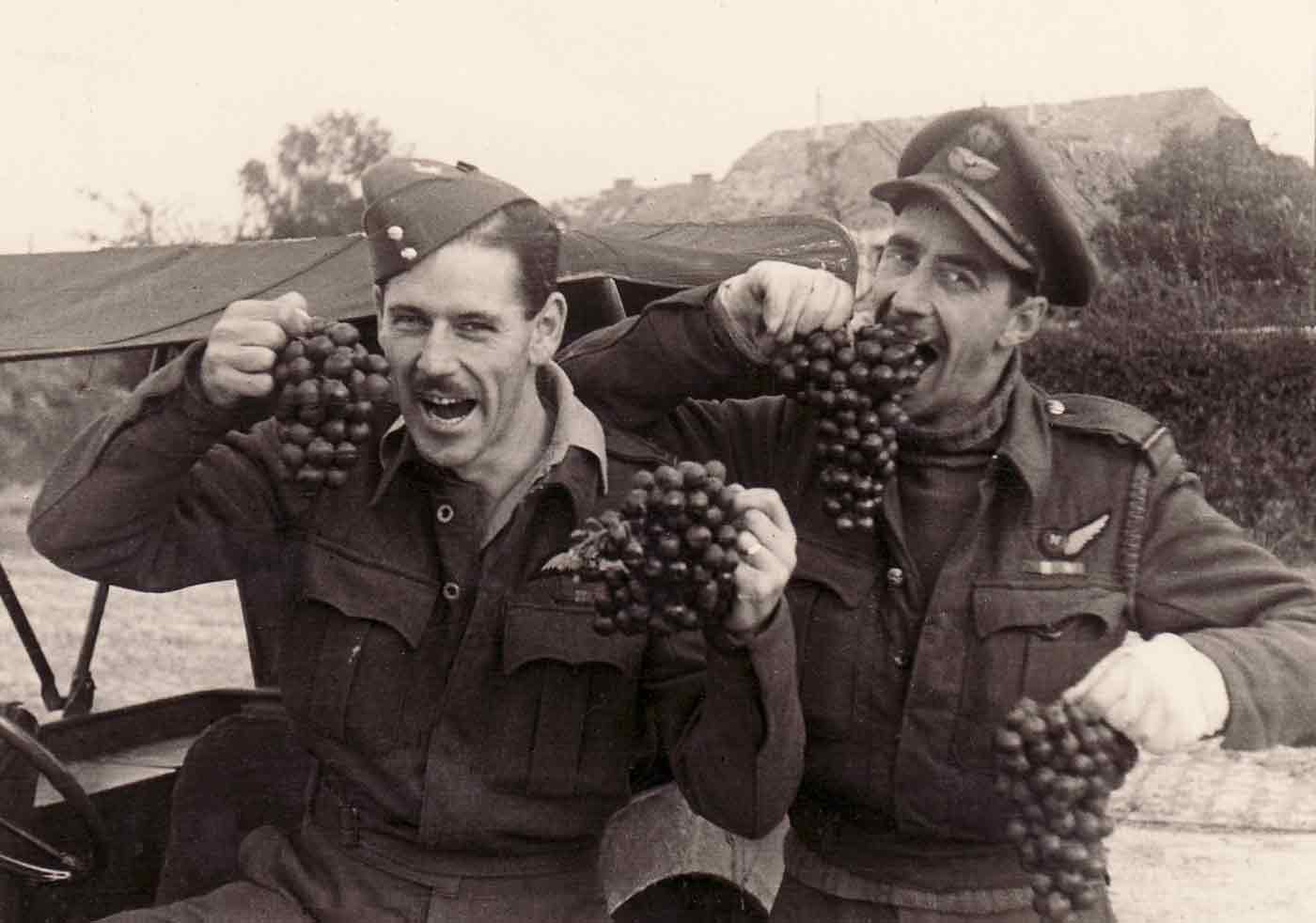1944
Mozzies for Beaus
In March 1944 the squadron realized the fulfilment of a long-awaited desire when they began turning in their valiant old Beaus for sleek new de-Havilland Mosquitoes, at that time the fastest aircraft in the world. The switch-over to Mossies was a sign that better things were in store for the Nighthawks. Other significant changes that heralded the end of their long period of inactivity was their transfer to No. 85 (Base) Group of 2nd Tactical Air Command, and their move south, first to West Mailing in Kent and then to Hunsdon, Herts, where No. 410 Squadron was stationed. In May the ban on night fighters chasing bandits across the Channel was lifted and the crews were issued with French money and maps. Action was obviously approaching.
409 Squadron in a formal photo in front of one of their Mosquito Mk XIII’s. The invasion markings date this picture as June 1944 or later. Dad is seated, 2nd in from the left in the front row.
That night F/0 H. F. (“Red”) Pearce with F/O G. W. Moores (RAF) as his navigator scored the squadron’s first victory in over a year when they probably destroyed a German bomber over the English coast.
The next night, working with mobile GCI units that had gone ashore with the assault forces, 409 Sqn. flew its first sorties over the beachhead. Patrols on the 6th, 7th, and 8th were uneventful, largely be-cause the Luftwaffe, apart from a few scattered raids, were late getting into the fray. On the 9th S/L R. S. Jephson, “B” flight commander, got the squadron’s first kill over France. Jephson and his navigator, F/O C. D. Sibbett, were flying on a beachhead patrol when the controller vectored them after a bandit. Sibbett’s AI soon registered a “blip” and the navigator brought his pilot onto the tail of a Ju. 188. Following standard night fighting procedure Jephson closed in, identified his target, and opened fire.
Dad hand colored this photo of his Mk XIII Mosquito MM590 with invasion markings at Hunsdon in mid 1944. The image of the Gooser can be seen on the hull just below the cockpit.
THREE IN ONE NIGHT
The next night “A” flight of 409 Sqn. experienced the satisfaction of shooting down three enemy planes in one night’s operations. F/Os C. J. Preece and W. H. Beaumont distinguished themselves on this occasion by destroying two Ju. 188s. Preece knocked down his first victim with a fine bit of deflecting shooting, scoring three times with three bursts. Continuing their patrol the Nighthawk crew were vectored after another bogey about three quarters of an hour later. Beaumont got a contact on his AI showing the target aircraft to be 8000 feet ahead and he brought Preece gradually onto it. At 3000 feet they got a visual, at 2500 feet they recognized it as another Ju. 188, and at 800 feet Preece fired a onesecond burst that caused the enemy aircraft to explode in the air so violently that the Mosquito pilot had to pull up sharply to avoid a wing which had broken off.
The other kill went to F/Os R. L. Fullerton and P. Castellan. Fullerton had a little difficulty getting onto the tail of his target. Finally, after following fourvectors “where I suspect I overshot each time,” the crew got an AI contact at a range of two miles. From thereon the interception was straight forward. Two bursts from the Mosquito’s guns sent the German aircraft spiralling earthwards with the starboard engine on fire.
To add to the night’s achievements S/L J. A. (Johnny) Hatch, “A” flight commander, returned from the beachhead with one engine u/s and made a perfect landing. “All in all it was a good night and “A” flight of 409 went to bed with that satisfied feeling.” In the 25-day period from D-Day to 30 June No. 409 Sqn. saw more action than in the previous three years of their night fighting operations. They flew a total of 227 night sorties, destroyed 11 enemy aircraft, probably destroyed two, and damaged five. They operated over the Normandy beachhead every night except one, the 26th, when patrols that had taken off had to be recalled due to duff weather. Casualties for this period included one crew taken prisoner of war and one crew killed when their aircraft hit high tension wires on returning from a patrol. Two other aircraft were written off from the results of crashes, but the crews were uninjured.
Dad (right) and Joe standing beside MM590 in their flight gear, including the famous ‘Mae West’ life jacket.
HEROIC EXPLOITS
On 6 August the squadron suffered another fatality that was also surrounded by heroic circumstances.
WC M. W. Beveridge, DFC, who had succeeded W/C J.W. Reid as GO at the end of July, had his
own aircraft (MM587) shot down by a Ju. 88hunting in formation with a FW. 190. As Beveridge and
his navigator, F/L John W. Peacock, prepared to abandon their disabled aircraft Beveridge got stuck
in the pilot’s escape hatch and Peacock couldn’t get the navigator’s door to jettison. Time was
running out when Peacock, deciding that at least one should survive the impending crash, rushed to
Beveridge’s assistance and pushed him free. There was just barely time for his parachute to open
before he hit the ground but Peacock didn’t have a chance and died in the crash.
Four nights later S/L J. A. Hatch and his navigator, F/L J. Eames (RAF), turned the tables on one of
these FW 190 — J u . 88 combinations. As they came within visual range of the two aircraft the FW.
190turned off to starboard and the intrepid Johnny followed it, knowing full well that at any
moment the Ju. 88 would start creeping up his tail. But before the German pilot had time to complete his manoeuver a two-second burst from the Mosquito sent the Focke-Wulf spiralling earthwards in flames. Hatch turned sharply, probing the night skies for the other adversary, but
further contacts turned out to be friendly bombers. A week later Hatch and Eames marked up a double-header, shooting down a Ju. 188 after a running fight and then blasting another Ju. 88out of the sky.
CROSS CHANNEL BASES
No. 409 Squadron had the distinction of being chosen as the first night-fighting unit to operate
from European soil. On 24 August, stripped of everything but the bare essentials of equipment,
they flew across the Channel to Carpiquet, near Caen, where an advance party under F/L V. L.
Fiksdal, the squadron engineering officer, had set up a maintenance section. Two weeks later the
mobile Nighthawks moved on to St. Andre and at the end of September they left that badly battered
airfield for Le Culot.
Mosquito NF Mk XIII MM560 at Le Coulot, 5 October 1944.
Dad and Joe Carpenter at Beauvechain, Belgum, where Le Culot airfield was located. Not having had fruit for so long in England they could not resist when a local farmer passing by with grapes being taken to the wine press were offered to them.
formerly of 410 squadron, was appointed CO.
On the same day that W/C Beveridge was reported missing, WO Len Fitchett and F/L A. C. Hardy had to leave their aircraft in a hurry when the port engine ran out of oil. On landing they were picked up by the French Maquis who received them royally, treating them to a hearty meal with plenty of good French wine. None the worse for their experience, they found their way back to the squadron and
made more news four days later by scoring the squadron’s first kill from a continental air base.
On the night of 6 October more excitement developed around Le Culot airfield than the Nighthawks had
seen since moving to the continent.Early in the evening F/L Gordon Sproule and F/O F. G. Wilkinson
were coming in for a single-engine landing when their undercarriage collapsed and the Mosquito
finished the run on its belly, much to the grief ofthe already overworked maintenance crews. Before
the runway could be cleared P/O F. E. (Hank) Haley called in on the R/T to say that he and P/O S. J.
(Fairy) Fairweather, DFM (RAF), had shot down a Ju. 88 and were coming in on one engine. Because
of the previous prang they couldn’t land at base and were being diverted whentheir other engine cut
out and they had to take to their parachutes. Just before midnight F/O R. H. Finlayson and his
navigator team-mate, F/O J. A. Webster, touched down with the news that they had destroyed an Me.
110. As a sort of finale to the eventful evening an aircraft from No. 410 Squadron force-landed at Le
Culot after destroying a German plane and getting badly shot up itself. Fortunately all went well and
the squadron diarist summed up the evening’s events as “a fairly good night.”
The day after W/C Somerville arrived the Nighthawks set out for Lille/Vendeville where they were
quartered in a beautiful old French chateau which had been used by the Luftwaffe during the German
occupation. The spacious dining room walls were finished in murals painted in Prussian military design
ironically depicting Hitler’s dreams of conquest. The squadron also fell heir to excellent dispersal huts
and ground crew flight rooms complete with a collection of easy chairs, tables, and double-decker spring
bunks for the night crews.
On 3 November, No. 410, the Cougar Squadron, joined the Nighthawks at Lille/Vendeville. Throughout
their wartime history these two units were closely associated; two of 409’s commanding officers, W/Cs
Davoud and Somerville, were formerly with the Cougars while two ex-Nighthawks, S/Ls G. H. Elms and
E. P. Heybroek, became commanding officers of 410. At Lille/Vendeville the two squadrons enjoyed
some good times together. On many an occasion when duff weather cancelled night flying the rafters
in the old chateau rang to the night fighters’ repertoire of air force and other songs as they gathered
round the piano with S/L George Bower at the keyboard. (Bower was now on his second tour with
409). *
These two pictures were among several turned over to the RAF Missing Research Section by a
photographer in Lille, France, after the war. Theyhad been left with him for developing by someone
in 409, but the squadron had been suddenly moved before the prints were called for. Negatives and
prints were passed to London, thence to Ottawa, where W/C Somerville (now G/C) helped to identify
the personnel.
The first three weeks of November passed so quietly that it seemed as if the Luftwaffe was spending
the winter in quarters but such was not the case. On 25 November both squadrons had a lively time.
No. 410 stole the show with Lt. A. A. Harrington (USAAF) shooting down three German aircraft; No.
409 was close behind as F/O R. E. Britten and F/L L. E. Fownes destroyed one Ju. 88 and damaged
another. There was more “trade” about the next night but the Germans dropped enough “window” in
the area to upset 85 Group’s radar system. Nevertheless two crews, WO R. A. Boorman – P/O W. J.
Bryant and F/L W. H. McPhail – F/O J. E. Donoghue, each made a free lance interception of a Ju.
87B.
WO E. F. (“King”) Cole and F/O W. S. Martin won the applause of their comrades on 29 November
for shooting down two Ju. 88s that were on the prowl for Mosquito patrols. About 1900 hours a burst
from Cole’s guns sent the first victim down in flames and half an hour later his cannon ripped into the
second Ju. 88 causing it to explode in the air. Debris flew inall directions filling the air intake of the
Mossie. A wing of the German plane smashed into Cole’s aircraft, knocking two feet off the nose and
bending the port propeller. Five minutes later the port engine of, the Mosquito stopped altogether. Then
the toughest part of the night’s operations began — getting safely back to base with one engine gone and
a kite that wouldn’t trim. They finally made it to a landing field at Brussels but came in a bit too high
and ended up unhurt in an old shell hole. Their double victory won an immediate award of the DFC.
December brought the inevitable thoughts of Christmas and of home; on days off the Nighthawks
carefully canvassed the shops at Lille, Brussels, and Ghent for gifts for families and friends. A few of
the more fortunate ones were able to carry their shopping activities further afield to Paris or London.
Ample time for wrapping the gifts was provided by the weather man who continually forecast rain,
snow, fog, and icing.
Yet in spite of the dirty December weather the Nighthawks had a good month operationally, thanks
to Hitler’s committing most of what was left of the Luftwaffe to his flash-in-the-pan offensive in the
Ardennes. On the night of 18 December, three German night fighters fell before the fire of 409
crews. One of these kills was registered by W/C Somerville who thereby made his first tally with the
Nighthawks; the others were made by P/O F. E. Haley and F/L R. H. Finlayson. A week later,
Britten and Fownes accounted for two Ju. 88s. The last engagement of the year was fought by S/L
Hatton and F/L Russ Rivers who out-manoeuvered another German night fighter and destroyed it
with a single burst.






